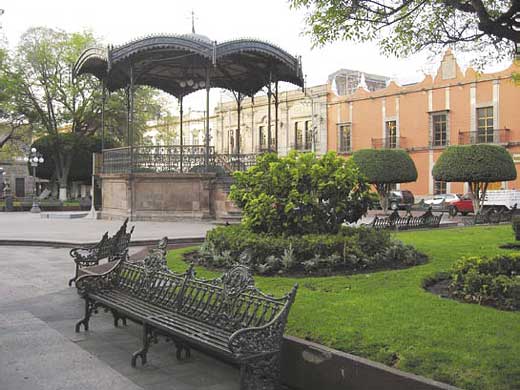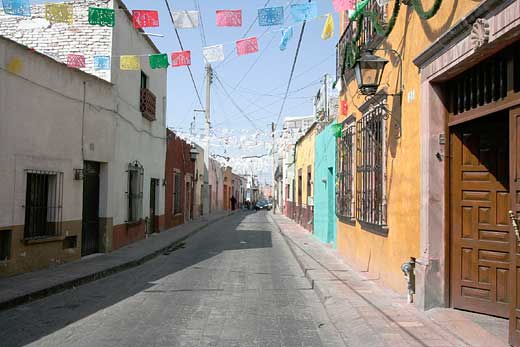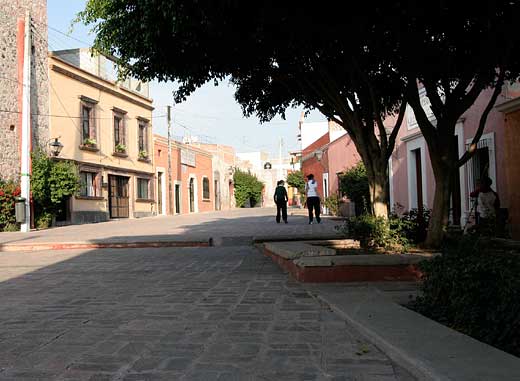
SPRING 2006
The Centro Historico De Querétaro
My first trip to Mexico takes me to an excellent city for the study of urbanism. Querétaro, a Central Mexican capital of nearly one million people, was founded in 1531 by Franciscan monks. Now it has miles of low-rise, medium-density sprawl, having suffered a growth spurt after the 1985 Mexico City earthquake when evacuees moved north, just as people from New Orleans have now swelled the population of Baton Rouge, La. But the historic town center of Querétaro has been protected. The portion of the city known as the Historic Monuments Zone, or Centro Historico, was named a UNESCO World Heritage site in 1996.
 Photo by Sandy Sorlien |
The UNESCO listing offers this description: "The old colonial town of Querétaro is unusual in having retained the geometric street plan of the Spanish conquerors side by side with the twisting alleys of the Indian quarters. The Otomi, the Tarasco, the Chichimeca and the Spanish lived together peacefully in the town, which is notable for the many ornate civil and religious Baroque monuments from its golden age in the 17th and 18th centuries."
I am here to work with architects who are graduate students in the new urbanism program at Tecnologico de Monterrey, Querétaro campus. We're beginning to analyze the entire city based on the rural-to-urban Transect, and talk about the SmartCode, the new urbanist land use ordinance that enables the kind of compact, walkable urbanism we find in the Centro Historico, an area of less than twenty square blocks.
 Photo by Sandy Sorlien |
I start by walking the Centro Historico and photographing. Immediately it is clear that this very old urbanism breaks many of the cardinal rules of the new urbanism. Yet the streets and plazas are busy, varied, safe, and beautiful. To what can we attribute this wonderful public realm?
As we figure that out, here are five of the broken rules.
1. The sidewalks are too narrow. There is no mitigating factor. They really are too narrow for comfortable walking. But it's worth it.
2. The block faces are closed and hostile after business hours. Again, it's true but worth it. Some doors and window shutters are ornamented or articulated such that they break up the streetwall agreeably, but some are quite implacable. However, the exciting tradeoff is that during business hours, most of these closed doors (many of them huge, as if made for castles,) are thrown wide open to passersby. The town has so much mixed use, it seems that nearly every other doorway opens to a business, whether it's a tiendita (little shop), courtyard cafe, or a government or professional office.
3. There are too many one-way streets. Most of the Centro Historico streets are very narrow, so they have to be one-way. This is a problem in places with less connectivity than Querétaro. But here the blocks are very short and there aren't many traffic signals. And because they are so narrow (and clogged with hapless pedestrians falling off the sidewalks into the travel lanes), the one-way streets don't create speedways, nor do they present delays to the driver. If you go the wrong way, you're not stuck for long.
4. There are many pedestrian-only streets (andadores). Typically in America, a com mercial street that gets closed to car traffic soon dies a horrible death. Consider Cumberland, Md., trapped in a 25-year decline since their main street was closed to cars. Philadelphia's Chestnut Street is now revived after being reopened to cars after several years of pedestrian-only retail decline.
But it works in Querétaro for two reasons: The andadores are usually only one block long, and the mixed-use in the Centro Historico is so thorough that an andador never becomes completely deserted in the day or evening.
5. All the housing is one type. Except on the far edges of the Centro, everything is attached rows of one or two stories. A few blocks go to three stories, but that is rare. One might think that this condition would lead to a monoculture of one income level, but it's clear that both lower and middle class citizens live here. (I am told by the students that the rich are attracted to American-style, single-use gated communities farther out. We visit some of those; they look like the subdivisions of the American Southwest.)
Some of the mitigating characteristics mentioned here help explain why this Mexican city can break so many rules and get away with it. Short blocks are key (see Portland, Ore., and Savannah, Ga.), as are narrow streets (see Philadelphia, Pa., and Boston, Mass.). Thorough mixed-use is essential (see Manhattan), and there must be attractive destinations. The streets of Querétaro, thanks to mayoral edict and armies of saffron-clad street cleaners, are immaculate; there is no litter and very little graffiti. The beauty of the plazas and churches and other architecture is important, but so is its culture of public life, centered around both the church and the local marketplace.
 Photo by Sandy Sorlien |
In fact, the public realm there is so compelling, the plazas are full of young couples kissing. Maybe Querétaro's small attached houses have something to do with that. (If there's no privacy anywhere, at least you can get away from your parents.) In contrast, American houses are growing larger as our public realm becomes more degraded. Everything is connected.